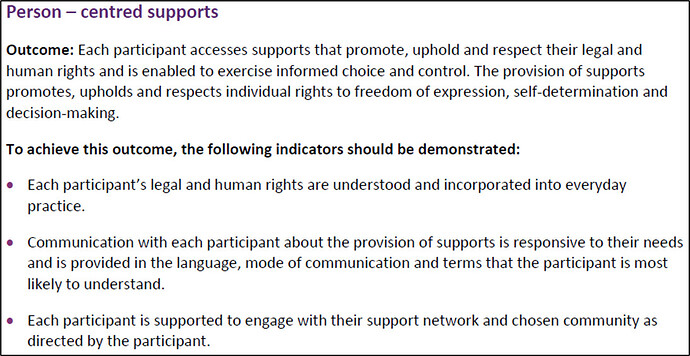The rights of participants and the responsibilities of providers make up the first section of the NDIS Practice Standards. This section is divided into the following outcomes:
- Person-centred supports
- Individual values and beliefs
- Privacy and dignity
- Independence and informed choice
- Violence, abuse, neglect, exploitation and discrimination.
Under each outcome is a list of indicators that enable providers to measure their progress towards the outcome. The below example of Person-centred Supports is pulled from the Practice Standards document.
Often, providers achieve all the necessary indicators but either lack the appropriate documentation or the link to the Practice Standards is unclear. One of the easiest ways to ensure you have covered all outcomes is to base at least one policy on each outcome, e.g. Person-centred Supports Policy and Procedure, Individual Values and Beliefs Policy and Procedure etc. Naming or creating your policies in this way ensures that the process is more streamlined come self-assessment or audit time.
This is especially handy as self-assessment can be the most time-consuming part of registration. You want to make the process as easy as possible while ensuring you represent all the great things you do accurately and succinctly within the 300-word limit.
The National Disability Scheme Insurance (Provider Registration and Practice Standards) Rules 2018 specify the evidence that auditors are required to collect. This includes:
- Information directly from participants
- Information from families/friends/carers/nominees and/or independent advocates (with participant consent)
- The documented support plan and evidence of delivery of supports to execute the plan
- All the supports delivered by the NDIS provider to the participant.
There is a free but incomplete document, the NDIS Practice Standards Interpretive Guide that can help with this process if you’re just getting started. However, to save some time I have also included the types of documentation that could be used for each outcome below. This information will of course differ depending on the size and proportion of each organisation. It is by no means a one-size-fits-all approach.
All five outcomes have types of evidence in common. These include:
- Company Values, Vision, Mission statement: Demonstrates commitment to the Practice Standards, Code of Conduct, Rights and Responsibilities.
- Easy-to-read documents: Catering to the different communication styles of participants.
- Feedback and Complaint Form and Register: Documents participant and their family/carer satisfaction which provides valuable information for the improvement of supports and services. This is linked to the dedication to continuous improvement by the provider.
- NDIS Code of Conduct: Signed copies by staff demonstrating their commitment.
- Participant Satisfaction Surveys: Participant voices provide evidence of continuous improvement and evidence-based practice.
- Participant Charter of Rights and Responsibilities: Signed by participants to demonstrate they have been made aware of the rights and responsibilities of themselves and the provider.
- Participant File: Evidence of assessments, service agreements, and support plans.
- Participant Handbook: Provider information including policies and procedures for participants.
- Service Agreement: A contract between provider and participant that outlines the terms and conditions agreed to during the provision of supports and services.
- Staff Handbook: Outlining policies and procedures relevant to staff.
- Staff Induction Checklist: Evidence of a process in which staff are made aware of policies and procedures.
- Staff Position Descriptions: An important tool for legal compliance that outlines staff roles, responsibilities and training.
- Staff Training Matrix: Document and track staff training.
Other evidence is specific to a certain outcome. These are outlined below:
Person-centred Supports
- Authority to Act as an Advocate Form: Evidence of participant consent nominating another to act on their behalf (also relevant for Independence and Informed Choice and Violence, Abuse, Neglect, Exploitation and Discrimination).
- Internal Audit Program: The non-prejudiced review of the providers methods and processes to help identify strengths and areas of improvement.
Privacy and Dignity
- Continuous Improvement Plan: An organisation-wide commitment and concrete strategies to continually find ways of doing things better. An NDS Fact Sheet can be found here.
- Data Breach Response Plan: A plan on how to respond to security incidents that can impact privacy and confidentiality.
- Social Media Release Form: Evidence of participant consent to use photographs or videos of them for external communications.
- Participant Consent Form: Evidence of participant consent to gather and store their information to provide supports and services.
Violence, Abuse, Neglect, Exploitation and Discrimination
Incident Report & Register: A record of actions relating to responses or follow-up actions to incidents and progress with these. Linked to the continuous improvement plan.
The next article will focus on Section 2 of the Practice Standards: Provider Governance and Operational Management. Looking at the following outcomes:
- Governance and Operational Management
- Risk Management
- Quality Management
- Information Management
- Feedback and Complaints Management
- Incident Management
- Human Resource Management
- Continuity of Supports
- Emergency and Disaster Management
